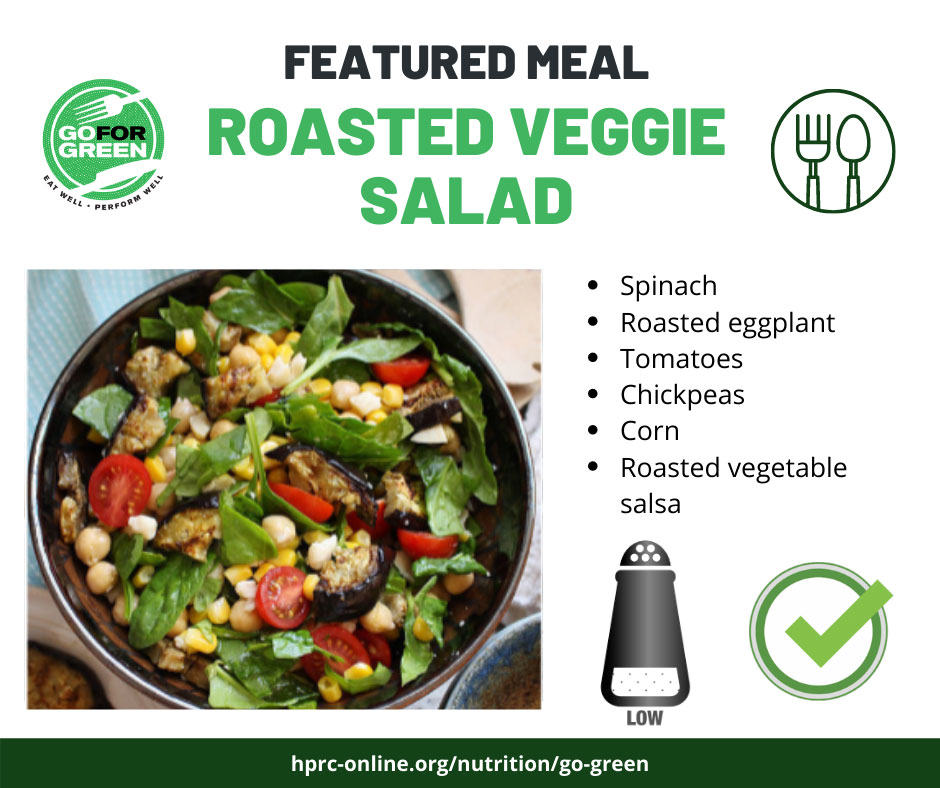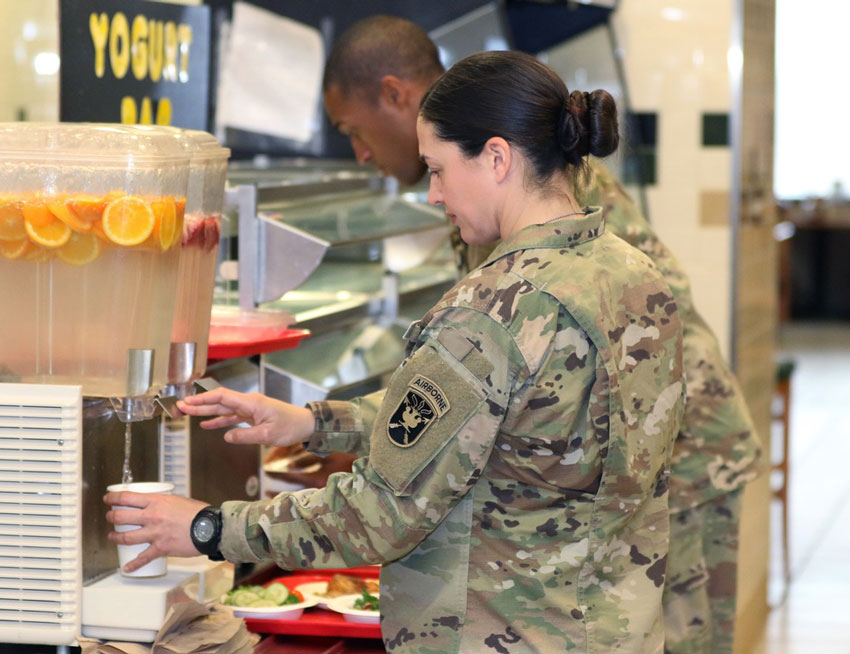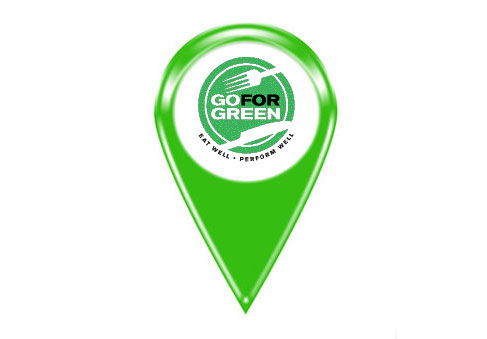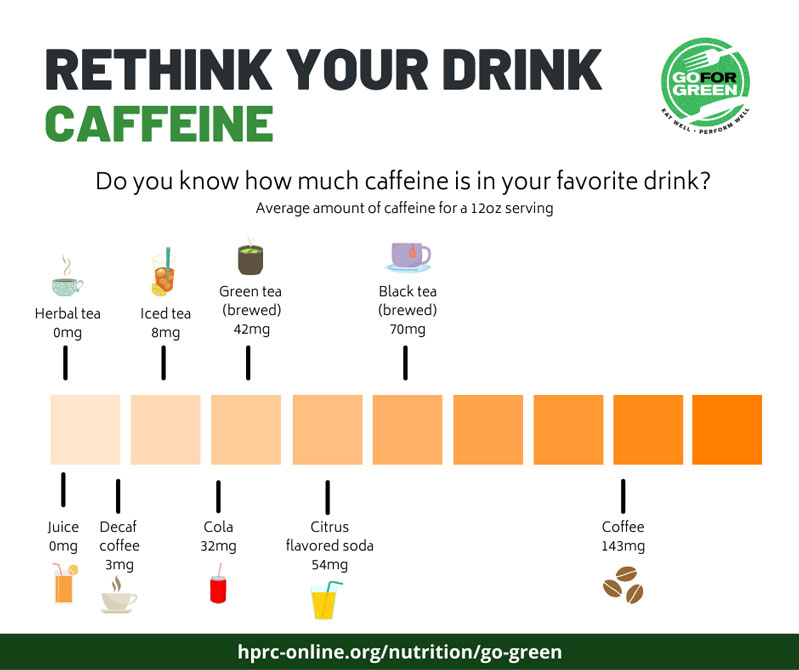You might notice at your local military dining facility or galley that foods and drinks are labeled with stoplight colors—Green, Yellow, and Red—to represent their nutritional quality. G4G labels can help you choose high-performance foods anywhere! Foods (except fruits) are also labeled Low, Moderate, or High based on their sodium content. G4G figures out the nutrition so you don’t have to!
Build a “Green” plate
 How do you feel when you’re low on energy? You might find it hard to focus at work, at home, or during training. The best way to energize is with foods that are high in nutrients. These “Green” foods help boost your mental and physical performance. No matter where you’re starting from, aim to increase the amount of “Green” items on your plate.
How do you feel when you’re low on energy? You might find it hard to focus at work, at home, or during training. The best way to energize is with foods that are high in nutrients. These “Green” foods help boost your mental and physical performance. No matter where you’re starting from, aim to increase the amount of “Green” items on your plate.
Need inspiration? Look for “Featured Meals” or “Featured Items” at your dining facility. Build your own bowl or plate with a wide variety of high-performance ingredients from different stations. For example, pair a salad or veggie side from a Specialty Bar with an entrée from the Mainline.
Rethink your drink
You can use caffeine to boost your mental and physical performance in certain situations. However, too much caffeine can negatively impact health, performance, and sleep. It’s important to be mindful of your daily caffeine intake both inside and outside the dining facility. Since G4G doesn’t include caffeine amounts when identifying drinks as Green, Yellow, and Red, use the chart above to estimate how much caffeine is in drinks commonly found at your dining facility. Plus, consider what you drink outside the facility to get an idea of your usual caffeine intake. Visit Operation Supplement Safety to learn more about caffeine and performance.
G4G hydration station
 When you dine in military dining facilities or galleys, let G4G guide your drink choices to hydrate smartly without all the extras. If your facility has a hydration station, head straight to it to find tasty Green-coded options. If you don’t see a dedicated hydration station, look for these low-calorie, low-sugar Green-coded drinks:
When you dine in military dining facilities or galleys, let G4G guide your drink choices to hydrate smartly without all the extras. If your facility has a hydration station, head straight to it to find tasty Green-coded options. If you don’t see a dedicated hydration station, look for these low-calorie, low-sugar Green-coded drinks:
- Water (plain or carbonated)
- Naturally flavored water, including fruit-, vegetable-, and herb-infused varieties (no artificial sweeteners)
- Herbal tea
- Unsweetened or very lightly sweetened iced or hot tea (≤ 11 grams of sugar per 16 oz)
- Unsweetened or very lightly sweetened iced or hot coffee (≤ 11 grams of sugar per 16 oz)
- 100% vegetable juice
- Milk, unsweetened (skim or 1%)
- Plant-based milk alternatives: unsweetened or plain soy, almond, or rice milk with added calcium and vitamin D
Choose “Green” on the go
Looking for convenient and nutritious to-go meals? Check out your installation’s Grab and Go station (at the main dining facility or market) for meals that “travel well,” help you refuel, and power your post-workout recovery plan. Look for Green-coded labels that identify high-performance options. Don’t see G4G labels? Choose meals that provide a balanced mix of lean protein, nutrient-rich veggies, and whole grains.
Fuel your recovery with G4G
Your facility might offer a G4G-labeled Recovery Bar with items to fuel your post-training recovery during meal periods or for takeout. Optimal Recovery Bars feature options to build meals or snacks with the right amount of carbohydrates (50–80 g), protein (16–24 g), and fluid to boost recovery. You might find G4G-labeled ingredients or pre-packaged recovery kits. If these options aren’t available, build your own recovery meals and snacks with items from your local dining facility, snack bar, or market. Here are some ideas:
![]() Kit #1: PB&J sandwich + 8 oz chocolate milk
Kit #1: PB&J sandwich + 8 oz chocolate milk
![]() &
& ![]() Kit #2: Greek yogurt (single-serving container) + ½ cup trail mix + piece of fruit
Kit #2: Greek yogurt (single-serving container) + ½ cup trail mix + piece of fruit
![]() Kit #3: Toasted oat cereal (single-serving container) + 8 oz milk (1%) + handful of nuts
Kit #3: Toasted oat cereal (single-serving container) + 8 oz milk (1%) + handful of nuts
![]() Kit #4: Whole-wheat pita + ½ cup hummus
Kit #4: Whole-wheat pita + ½ cup hummus
![]() Water (naturally flavored, carbonated, or plain)
Water (naturally flavored, carbonated, or plain)
![]() Unsweetened tea or coffee (*be mindful of caffeine)
Unsweetened tea or coffee (*be mindful of caffeine)
![]() Fresh fruit
Fresh fruit
![]() Fresh veggies (carrots or celery) with hummus
Fresh veggies (carrots or celery) with hummus
![]() Nuts or seeds
Nuts or seeds
![]() &
& ![]() Trail mix (*no added sugar preferred)
Trail mix (*no added sugar preferred)
![]() &
& ![]() Dried fruit (*no added sugar preferred)
Dried fruit (*no added sugar preferred)
![]() Jerky
Jerky

